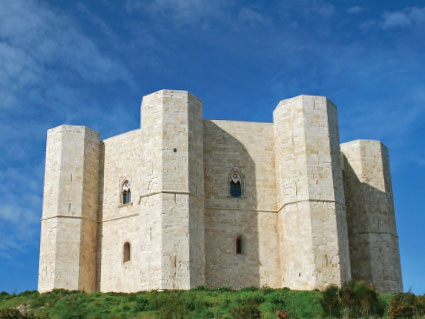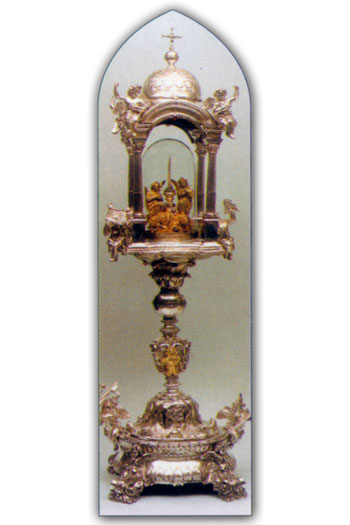





Many local historians and writers have studied the Holy Thorn mystery and among them one of the most accredited is Mons. Emanuele Merra, a wise and judicious scholar of the old records of Andria. “As far as the origin of one of the greatest thorns kept religiously in the Duomo of Andria – Merra writes – we must maintain with respect that it was donated not by Carlo D’Angiò, but by his son Carlo II”. The D’Angiò family, indeed, used to donate such relics to those cities where they lived or visited as a symbol of the relationship with the ruling family of France. The first confirmed records about the appearance of the prodigy of the Holy Thorn date back to 1633, but many believe that it had happened long before.
Here is the account by Mons. Merra: “the Holy Thorn of Andria is four fingers long and is as large like as a string yarn. Its colour is greyish except for the tip that is darker. Inside the thorn you can see four purplish stains just behind its bending and another placed in the front, as well as many others located in some points difficult to see. When the sixth feast of Parasceve coincides with the Annunciation Day, March 25th , these stains seem to brighten up and redden as live blood: this is the miracle”.
Many accounts of the prodigy have been recorded throughout centuries and in particular those happened in 1910, 1921, and 1932 are accurately registered. The latest dates back to 25th March 2005. What follows is the comment by the Bishop of Andria, Raffaele Calabro: “ I still feel a strong emotion […]. I use consciously the word extraordinary “sign” drawing it from the Gospel of John because such a word expresses more precisely than the other two words in vogue “miracle” and “prodigy” the path of faith that supports an occurrence or an event inexplicable by the mere reason. It is the duty of believers and non-believers to take note of events inexplicable both in terms of human knowledge and modern scientific means. The Holy Thorn is kept in the Cathedral in Andria open to the public.
A tradition during Lent in Andria that is no longer celebrated, was that of hanging straw dolls from a rope strung between two buildings of a street, with one doll for each week between the day of ashes to Easter. Each week one of these dolls was eliminated, burned, measuring out the weeks until the end of Lent, and therefore the arrival of Easter.
Holy Thursday
The sepulchre (the altar of repose) was decorated with blades of grasses, of wheat, barley, or lentil seeds, which our grandparents, about halfway through Lent, placed to grow in dark places so that they did not develop chlorophyll and took on a yellow colour; today it is decorated with various colourful flowers. Today as in the past, after the holy functions in church, the streets are full of the devout going from one church to another to visit the "sepulchres". Until a few decades ago, this was an occasion for many people to parade new clothes, especially young engaged couples who were accompanied from their homes and for the tour of the churches by the future mother-in-law and a group of relatives. The tradition used to be to visit at least seven altars of repose, including that of the church del Purgatorio, because this was, and still is, where the wooden statues of the Passion and death of Christ carried by the procession on Good Friday, were displayed Another characteristic was the incessant beating of a drum in front of the church. Another traditional occurrence that is no longer celebrated was that for every altar of repose visited, the devout ate a "confetto" a sugared almond, previously put aside for the purpose during Carnival.
Good Friday
After the re-enactment of the suffering of our Lord, preparations begin for the "procession of the mysteries", which wends its way through the streets as the evening draws in. Following age-old tradition, the procession is still led by many heavy wooden crosses. Today these carried on the shoulders of the "crociferi" or cross bearers of the association of the same name, but in the past they were carried by simple devout members of the population. These are followed by the statues of Christ in the olive garden, Christ at the column, Christ with the cane, Christ bearing the weight of the cross, the Crucifixion, the Dead Christ, Our lady of Sorrows, and the group of statues of the Pious women, followed in turn by the miraculous relic the "Sacra Spina", purported to be a piece of the crown of thorns. In the past the group of statues representing the Pious women (of recent manufacture) did not exist, and the "Sacra Spina" was accompanied by a relic of the True Cross kept in its own reliquary.
Holy Saturday
Until a few decades ago, this was the day of the Resurrection. At midday, during the celebration of the Pontifical Mass, with the "Gloria in excelsis Deo" the bells of the town that had been kept silent during Lent would ring out in celebration, announcing the Resurrection of Christ; the sound of the bells was joined by the noise of fireworks. The whole town celebrated, and it was traditional to make various sounds with wooden clubs to chase "u paponne" (the devil) out from under the beds and out of the houses. Then the streets would come alive with young people bearing gifts: lambs with red bows around their necks, baskets full of eggs, sugar sheep, large iced donuts decorated with small chocolate eggs (the scarcelle or “rë scarcidd”) which the families of engaged couples exchanged. The tradition was to give the engaged man a shirt and tie, along with a gift made of gold.
Easter Sunday
Tradition dictated that lunch should start with boiled eggs (a tradition that is still in use), followed by slices of "soppressata" (a special cold cut), and then other dishes: baked stuffed pasta timbale, roast lamb, and lots of other delicacies all accompanied by good wine. During the afternoon of Easter Sunday the in-laws, with the closest family members of the future groom, would make their way to the house of his betrothed bearing gifts known as "u chngirt" comprising a gold necklace, earrings, and bracelet. Once they reached the betrothed's house, the future bride would offer painted boiled eggs prepared by her mother or else "rë scarcidd" or a piece of "calzaunë", foccacia filled with onions, olives, and anchovies.
Easter Monday
This feast day used to have two traditional activities: the people of Andria would prepare a lavish lunch, including "u calzaunë dë cambrë" (foccacia filled with ricotta, eggs and other ingredients), a vegetable soup, or else cardoons, boiled, cooked in stock and dressed with beaten eggs and cheese. Many on the other hand, would set off early in the morning in trains or by horse and cart towards the famous Calentano sanctuary in Ruvo. During the afternoon, the procession of Angels made up of children dressed in white as angels, or as St John wearing a pair of trousers and a lambskin on their bare shoulders, would start from the church dell'Annunziata.
BIBLIOGRAPHY: Antonia Musaico Guglielmi – “passato e presente nelle tradizioni andriesi” (the past and present traditions in Andria) Printed by Guglielmi .- Andria September 1988 Vincenzo Quagliarella – “Per non dimenticare come eravamo” (so as not to forget how we were) Grafiche Guglielmi s.n.c. – Andria 1995